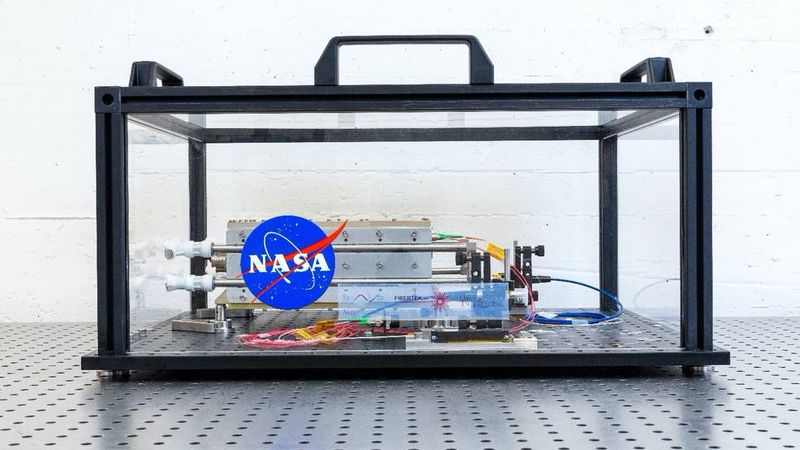NASA Provides Laser for LISA Mission
Finding the biggest collisions in the universe takes time, patience, and super steady lasers.

The first prototype of a laser sits on a testbed at the Swiss Center for Electronics and Microtechnology (CSEM), headquartered in Neuchâtel, Switzerland. CSEM will test and characterize the laser, which will be used to conduct gravitational wave experiments in space for the LISA mission. Credits: European Space Agency/CSEM
Finding the biggest collisions in the universe takes time, patience, and super steady lasers.
In May, NASA specialists working with industry partners delivered the first prototype laser for the European Space Agency-led Laser Interferometer Space Antenna, or LISA, mission. This unique laser instrument is designed to detect the telltale ripples in gravitational fields caused by the mergers of neutron stars, black holes, and supermassive black holes in space.
Anthony Yu at NASA’s Goddard Space Flight Center in Greenbelt, Maryland, leads the laser transmitter development for LISA.
“We’re developing a highly stable and robust laser for the LISA observatory,” Yu said. “We've leveraged lessons learned from previous missions and the latest technologies in photonics packaging and reliability engineering. Now, to meet the challenging LISA requirements, NASA has developed a system that produces a laser transmitter by using a low-power laser enhanced by a fiber-optic amplifier."
The team is building upon the laser technology used in NASA’s Gravity Recovery and Climate Experiment, or GRACE, mission. “We developed a more compact version as a master oscillator,” Yu said. “It has much smaller size, weight, and power consumption to allow for a fully redundant master oscillator for long-duration lifetime requirements.”
The LISA laser prototype is a 2-watt laser operating in the near-infrared part of the spectrum. “Our laser is about 400 times more powerful than the typical laser pointer that puts out about 5 milliwatts or less,” Yu said. “The laser module size, not including the electronics, is about half the volume of a typical shoe box.”
The Swiss Center for Electronics and Microtechnology (CSEM), headquartered in Neuchâtel, Switzerland, confirmed receipt of the lasers and will begin testing them for stability.
LISA will consist of three spacecraft following Earth in its orbit around the Sun and flying in a precision formation, with 1.5 million miles (2.5 million kilometers) separating each one. Each spacecraft will continuously point two lasers at its counterparts. The laser receiver must be sensitive to a few hundreds of picowatts of signal strength, as the laser beam will spread to about 12 miles (20 kilometers) by the time it reaches its target spacecraft. A time-code signal embedded in the beams allows LISA to measure the slightest interference in these transmissions.
Ripples in the fabric of space-time as small as a picometer – 50 times smaller than a hydrogen atom – will produce a detectable change in the distances between the spacecraft. Measuring these changes will give scientists the general scale of what collided to produce these ripples and an idea of where in the sky to aim other observatories looking for secondary effects.
These gravitational wave fluctuations are so small they would be obscured by external forces such as dust impacts and the radiation pressure of sunlight on the spacecraft. To mitigate this, the drag-free control concept – demonstrated on the LISA Pathfinder mission in 2015 – uses free-floating test masses sheltered inside each spacecraft as reference points for the measurement.
LISA expands on work by the National Science Foundation’s Laser Interferometer Gravitational-Wave Observatory (LIGO), which captured its first recording of gravitational waves in 2015. Since then, the pair of ground-based observatories in Hanford, Washington, and Livingston, Louisiana, have captured four dozen mergers.
Thomas Hams, program scientist for LISA at NASA Headquarters in Washington, said the precision laser measurements will allow us to zoom in on the gravitational wave signatures of these mergers and enable other observatories to focus on the right part of the sky to capture these events in the electromagnetic spectrum.
NASA’s Fermi Gamma-ray Space Telescope picked up the first such multimessenger observation just seconds after LIGO detected a merger of two neutron stars through gravitational waves.
“With LISA, the hope is you will be able to see these things develop before the merger actually happens,” Hams said. “There will be an indicator that something is coming.”
Industry Partnership
To achieve the required stability, the team brought Fibertek Inc. in Herndon, Virginia, and Avo Photonics Inc. in Horsham, Pennsylvania, to develop the laser, oscillator, and power amplifier, and an independent optical engineer in San Jose, California.
Avo Photonics built the laser for the observatory.
“Here you have the challenges of spaceborne ruggedness needs, on top of submicron-level optical alignment tolerance requirements. These really push your optical, thermal, and mechanical design chops,” Avo Photonics President Joseph L. Dallas said. “In addition, the narrow linewidth, low noise, and overall stability needed for this mission is unprecedented.”
Photonics pioneer Tom Kane invented the monolithic laser oscillator technology that Goddard used to stabilize the frequency of the laser light. “Your average laser can be very messy,” Kane said. “They can wander all around their target frequency. You need a ‘quiet’ laser that’s exactly one wavelength and a perfect beam out to 15 decimal places of accuracy.”
His oscillator technology uses feedback loops to keep the laser burning at such precision. “The wavelength ends up becoming the ruler for these incredible distances,” Kane said.
The high-power, low-noise amplifier came from Fibertek.
Fibertek also contributed to NASA’s Ice Cloud and Land Elevation Satellite (ICESat) 2 and the Cloud-Aerosol Lidar and Infrared Pathfinder Satellite Observation (CALIPSO), which has been operating a laser pointed at Earth for 15 years.
Including time for testing on the ground and potential mission extensions, LISA’s lasers must operate without skipping a hertz for up to 16 years, Goddard’s Yu said.
“Once launched, they will need to be in 24/7 operation for five years for the initial mission, with a possible six to seven years of extended mission after that,” Yu explained. “We need them to be stable and quiet.”